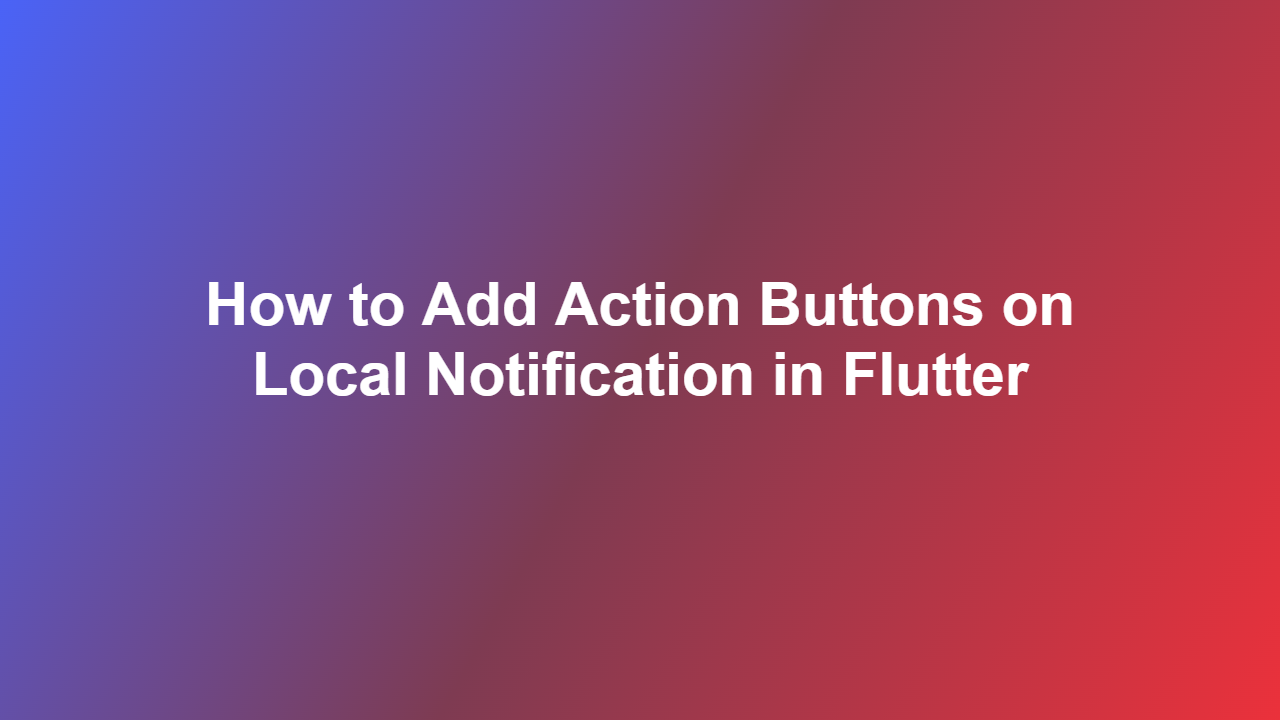How to Add Action Buttons on Local Notification in Flutter
Introduction
Local notifications are an essential part of any mobile app, allowing users to receive timely updates and alerts without necessarily opening the app. In Flutter, you can easily create and manage local notifications using the `flutterlocalnotifications` package. However, one limitation of this package is that it doesn’t support action buttons on local notifications out-of-the-box. In this article, we’ll show you how to add action buttons to your local notifications in Flutter.
Why Action Buttons are Important
Action buttons are small, clickable elements that can appear on top of a notification. They allow users to perform specific actions without having to open the app. Action buttons can improve user experience and increase engagement with your app. With action buttons, users can:
– Respond to notifications without opening the app
– Take immediate action on a notification
– Interact with the app in a more seamless way
Requirements
Before you start, make sure you have the following installed:
– Flutter 2.5 or later
– Dart 2.12 or later
– `flutterlocalnotifications` package added to your `pubspec.yaml` file
Here’s an example of how to add the `flutterlocalnotifications` package to your `pubspec.yaml` file:
“`yaml
dependencies:
flutterlocalnotifications: ^9.5.1
“`
Step 1: Initialize the Local Notification Package
First, you need to import the `flutterlocalnotifications` package and initialize it in your `main` function. Here’s an example:
“`dart
import ‘package:flutter/material.dart’;
import ‘package:flutterlocalnotifications/flutterlocalnotifications.dart’;
void main() {
WidgetsFlutterBinding.ensureInitialized();
final FlutterLocalNotificationsPlugin flutterLocalNotificationsPlugin =
FlutterLocalNotificationsPlugin();
WidgetsFlutterBinding.ensureInitialized();
// Initialize the plugin. See plugin’s docs for other initialized settings.
AndroidInitializationSettings initializationSettingsAndroid = AndroidInitializationSettings(‘@mipmap/ic_launcher’);
IOSInitializationSettings initializationSettingsIOS = IOSInitializationSettings();
InitializationSettings initializationSettings = InitializationSettings(android: initializationSettingsAndroid, iOS: initializationSettingsIOS);
await flutterLocalNotificationsPlugin.initialize(
initializationSettings,
onSelectNotification: onSelectNotification,
);
runApp(MyApp());
}
“`
Step 2: Create a Local Notification with an Action Button
Next, you need to create a local notification with an action button. You can do this by using the `show` method of the `flutterLocalNotificationsPlugin` instance. Here’s an example:
“`dart
void _showNotification() async {
final FlutterLocalNotificationsPlugin flutterLocalNotificationsPlugin =
FlutterLocalNotificationsPlugin();
var androidPlatformChannelSpecifics = AndroidNotificationDetails(
‘yourchannelid’,
‘yourchannelname’,
‘yourchanneldescription’,
importance: Importance.max,
priority: Priority.max,
icon: ‘ic_launcher’
);
var iOSPlatformChannelSpecifics = IOSNotificationDetails();
var platformChannelSpecifics = NotificationDetails(
android: androidPlatformChannelSpecifics,
iOS: iOSPlatformChannelSpecifics);
await flutterLocalNotificationsPlugin.show(
0,
‘Action Button Notification’,
‘This is a notification with an action button’,
platformChannelSpecifics,
payload: ‘Add action button’,
);
}
“`
Step 3: Handle Action Button Clicks
When an action button is clicked, you need to handle the click event. You can do this by using the `onSelectNotification` method of the `flutterLocalNotificationsPlugin` instance. Here’s an example:
“`dart
Future onSelectNotification(String payload) async {
if (payload != null) {
debugPrint(‘Notification payload: $payload’);
}
// Handle action button click
_handleActionButtonClick();
}
void _handleActionButtonClick() {
// Handle action button click logic here
debugPrint(‘Action button clicked!’);
}
“`
Step 4: Display the Action Button
Finally, you need to display the action button on the notification. You can do this by using the `android` property of the `NotificationDetails` class. Here’s an example:
“`dart
var androidPlatformChannelSpecifics = AndroidNotificationDetails(
‘yourchannelid’,
‘yourchannelname’,
‘yourchanneldescription’,
importance: Importance.max,
priority: Priority.max,
icon: ‘ic_launcher’)
..setCategory(‘standard_template’)
..setLargeIcon(BitmapFactory.decodeResource(context.resources, R.drawable.icnotificationlarge));
“`
Conclusion
Adding action buttons to local notifications in Flutter is a simple process that can improve user experience and increase engagement with your app. By following the steps outlined in this article, you can easily add action buttons to your local notifications and handle action button clicks.
FAQs
1. Q: What is the difference between `AndroidNotificationDetails` and `NotificationDetails` classes?
A: The `AndroidNotificationDetails` class is used to specify Android-specific settings for a notification, while the `NotificationDetails` class is used to specify settings that are common to both Android and iOS platforms.
2. Q: How do I handle action button clicks on iOS?
A: To handle action button clicks on iOS, you need to use the `IOSNotificationDetails` class and specify an `actionId` property. Then, you can use the `onSelectNotification` method to handle action button clicks.
3. Q: Can I customize the appearance of action buttons?
A: Yes, you can customize the appearance of action buttons by using the `android` property of the `NotificationDetails` class. You can specify settings such as `icon`, `iconColor`, and `iconGravity` to customize the appearance of action buttons.
4. Q: How do I add multiple action buttons to a notification?
A: To add multiple action buttons to a notification, you need to use the `actions` property of the `AndroidNotificationDetails` class. Each action button is represented by an `AndroidNotificationAction` object, which specifies settings such as `id`, `title`, and `activity`.
5. Q: Can I use action buttons on notifications that are generated by a third-party service?
A: Yes, you can use action buttons on notifications that are generated by a third-party service. However, the service must support action buttons and provide a way to specify custom actions for the notification.
